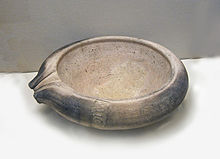Mortarium
In the Roman Empire, ceramic vessels that were used to grind and mix dairy products, herbs and spices were referred to as mortariums (Latin for “grating bowl” or “bowl”) . Today in the kitchen a mortar made of harder material and a pestle are usually used for this activity .


Would
The most frequently used coarse ceramic mortaria have a flat base, less often a base ring. The height is usually less than half the diameter of the opening. They needed a wide rim or collar so that you could hold them in your hand. Both edge forms had a rough rubbing surface on the inside, which consisted of fine quartz or limestone gravel. Fine grooves can also be found there on pieces from the first century. A spout on the side made it easier to empty the vessel. The shape of the vessels hardly changed over several centuries until late antiquity , which is why they are not very suitable as a means of dating. Early Mortaria from the northwestern provinces occasionally have manufacturer's stamps on the edge.
Mortaria , unlike modern mortars, were used more for mixing and kneading dough, cheese, and dough-like mixtures. The finds always show most signs of wear in the lower area of the bowl, which suggests a touching rubbing process. Occasionally the floors are punctured due to improper handling. A pestle ( pistillum ) is part of the use of the bowls . However, such a mortar has never been found in connection with a mortar. It stands to reason that these were made of perishable material, probably wood.
Mortars from the Raetian ware often had a glossy coating and a painted rim. Towards the end of the 2nd century AD, mortars made of terra sigillata appear ( shapes Drag. 43 and 45 ), which indicate a change in table culture. Obviously, the sauces were now prepared directly at the table, which is why higher-quality goods were preferred.
distribution
Grating bowls originally come from the eastern Mediterranean. They have been in Asia Minor since the 11th century BC. Known, possibly originate from oriental influences. Occasionally they have been in Greece since the 7th century BC. BC, in common use from the 5th century. In Italy they are before the 2nd century BC. BC hardly to be proven. The use of clay mortars spread quickly; they can be found in the finds from the Roman camps of Numantia in the same century .
Like most of the rough kitchen ceramics, Mortaria were produced in local workshops and sold regionally. There were few potteries in Gaul that exported their products over long distances. The frequent occurrence of mortaria in Central Europe since the time of the Roman occupation can be interpreted as an adoption of Mediterranean table manners and thus be an indication of Romanization .
use
Clay mortars were primarily used to grind or mix various seasoning sauces that were widely used in Roman cuisine. Some of these sauces are mentioned in Apicius' cookbook . To serve this, small bowls and bowls were part of the usual tableware. Mortaria will have been used particularly frequently to make Moretum . In this usage they are mentioned in the poem moretum .
literature
- Dietwulf Baatz : mortar and Romanization. In: Rei Cretariae Romanae Fautores Acta. 17/18, 1977, pp. 147-158.
- Erich Gose: Types of vessels in Roman ceramics in the Rhineland. Cologne 1976, ISBN 3-7927-0293-2 , p. 39f.
- Werner Hilgers : Latin vessel names. Names, function and shape of Roman vessels based on ancient written sources. Rheinland-Verlag, Düsseldorf 1969, pp. 68-70 u. Cat.-No. 248.
- Constanze Höpken: Other ceramics. In: Thomas Fischer (Ed.): The Roman Provinces. An introduction to their archeology. Theiss-Verlag, Stuttgart 2001, ISBN 3-8062-1591-X , pp. 293-300.
Web links
Individual evidence
- ↑ Dietwulf Baatz : mortar and Romanization. In: Rei Cretariae Romanae Fautores Acta. 17/18, 1977, p. 147.
- ↑ W. Hilgers: Latin vessel name. Names, function and shape of Roman vessels based on ancient written sources. Rheinland-Verlag, Düsseldorf 1969, p. 68.
- ↑ Dietwulf Baatz: Fort Hesselbach and other research on the Odenwald Limes. Gebr. Mann, Berlin 1973, ISBN 3-7861-1059-X , p. 106.
- ↑ Dietwulf Baatz: mortar and Romanization. In: Rei Cretariae Romanae Fautores Acta. 17/18, 1977, p. 155.
- ↑ Parody of Virgil's poem from the appendix Vergiliana (1st century AD).


